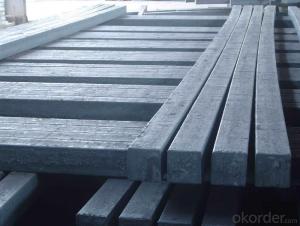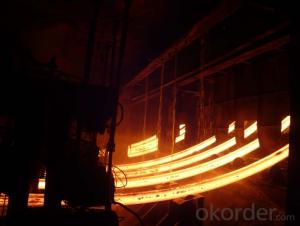Square Steel Billet Q235 3SP Grade Prime Quality 4#
- Loading Port:
- Tianjin
- Payment Terms:
- TT OR LC
- Min Order Qty:
- 2000 m.t
- Supply Capability:
- 50000 m.t/month
OKorder Service Pledge
OKorder Financial Service
You Might Also Like
Description of Square Steel Billet Q235 3SP Grade Prime Quality 4#
M. S. Billets are used for rolling of TMT Re-Bars of Fe415 and Fe500 Grade and various other structural steel products.
CRS Billets are used for rolling of CRS TMT Re-Bars.
Special Alloy Billets are used for rolling of any special grade TMT Re-Bars like Earthquake resistant TMT Re-Bars and for special grade structural steel products.
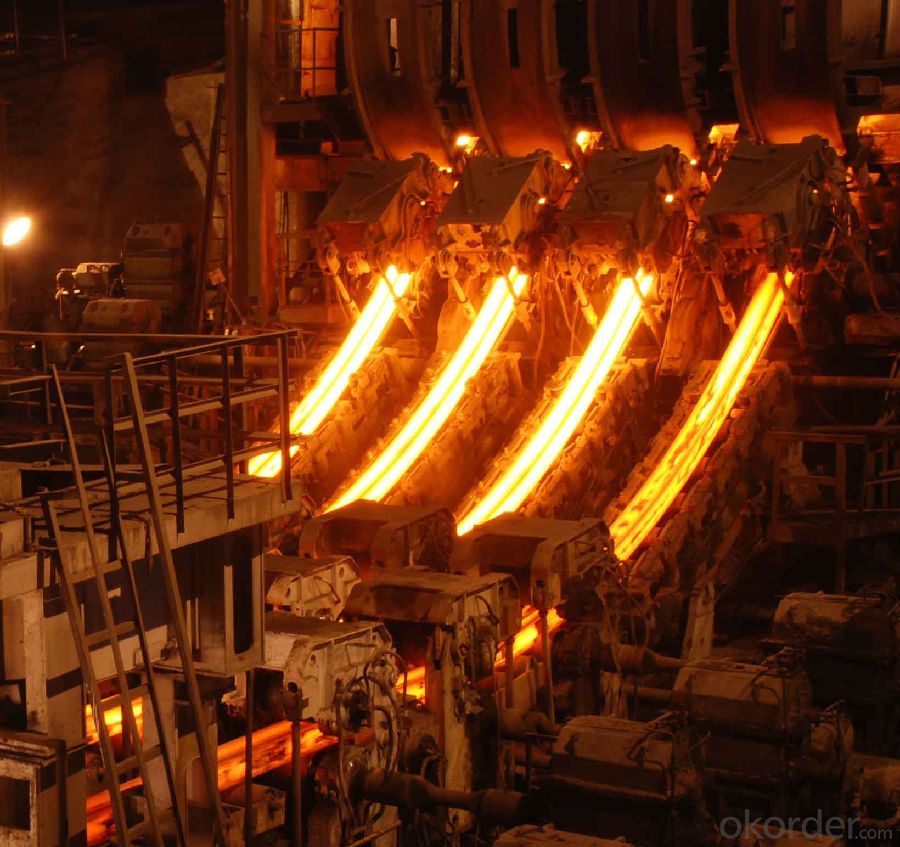
Main Feature Square Steel Billet Q235 3SP Grade Prime Quality 4#
Raw elements(C,Fe,Ni,Mn,Cr,Cu.)---Smelted ingots by AOD finery---hot rolled into black suface---pickling in acid liquid---cold drawn----polished by automatically machine--- cutting into pieces---checking quanlity
Applications of Square Steel Billet Q235 3SP Grade Prime Quality 4#
Widely Used in the areas such as Stainless Steel Fasteners, Chains, Kitchen and Sanitary wares, Furniture handles, Handrails, Electroplating and Electrolyzing pendants, Foods, Electron, Petroleum, Construction and Decoration, etc. Products have a high strength after cold-working. Electronic products parts, Medical appliance, Springs, Bus Inside and Outside packaging and building, Street Lamp Posts, etc. Decoration materials and Outdoor Publicity Billboard. Used for the products which have the Anti-Stress Corrosion requirement. Electron Products, Table-wares, Bolts, Nuts, Screen Meshes, Cumbustors and so on.
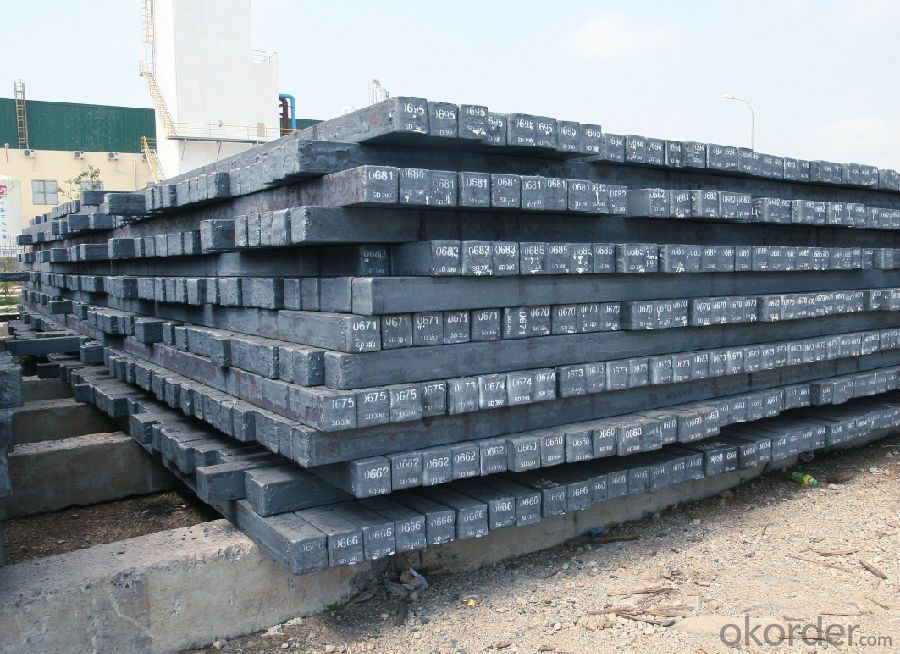
Specifications of Square Steel Billet Q235 3SP Grade Prime Quality 4#
| Standard | C(%) | Mn(%) | S(%) | P(%) | Si(%) |
| Q195 | ≤0.12 | ≤0.50 | ≤0.040 | ≤0.035 | ≤0.30 |
| Q235 | ≤0.20 | ≤1.40 | ≤0.045 | ≤0.045 | ≤0.35 |
| Q275 | ≤0.22 | ≤1.50 | ≤0.045 | ≤0.045 | ≤0.35 |
| 20MnSi | 0.17-0.25 | 1.2-1.6 | ≤ 0.050 | ≤ 0.050 | 0.40-0.80 |
| 3SP | 0.14-0.22 | 0.40-0.85 | ≤ 0.050 | ≤ 0.040 | 0.05-0.15 |
| 5SP | 0.28-0.37 | 0.50-1.00 | ≤ 0.050 | ≤ 0.040 | 0.15-0.30 |
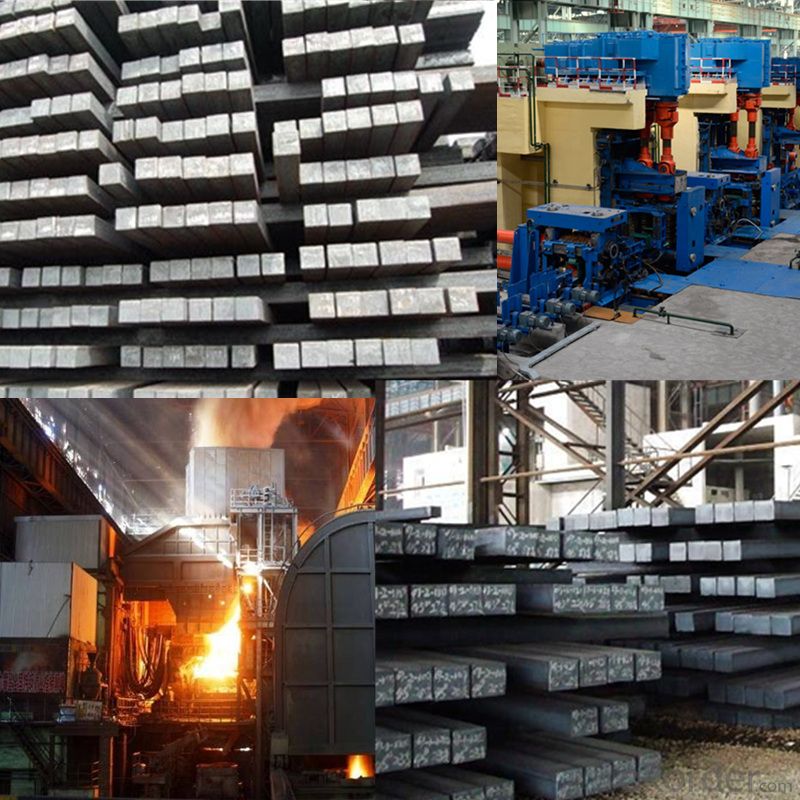
FAQ of Square Steel Billet Q235 3SP Grade Prime Quality 4#
We have organized several common questions for our clients,may help you sincerely:
1. How Can I Visit There?
Our company is located in Tianjin City, China, near Beijing. You can fly to Tianjin Airport Directly. All our clients, from home or aboard, are warmly welcome to visit us!
2. How Can I Get Some Sample?
We are honored to offer you sample.
3. Why choose CNBM?
Our delivery time about 15-20days for standard sizes, if you have other requirements like hardness, quanity and width ,it is about 20-40days. But don't worry we also try our best for the delivery time ,because time longer and our cost is higher.
- Q:How are steel billets used in the manufacturing of hydraulic systems?
- The manufacturing of hydraulic systems relies on steel billets, which serve as the raw material for a variety of components. To withstand the high pressures and forces involved, hydraulic systems require sturdy and long-lasting parts. To shape the steel billets into the desired form, they are first heated and then processed through methods like hot rolling or extrusion. These processed steel billets are then further transformed into different hydraulic system components, including cylinders, pistons, valves, and fittings. The utilization of steel billets offers several advantages in the manufacturing of hydraulic systems. Firstly, steel is well-known for its strength and toughness, making it ideal for enduring the extreme pressures and forces experienced in hydraulic systems. Additionally, steel boasts excellent resistance to corrosion, which is essential given the exposure to fluids and harsh environments in hydraulic systems. Moreover, steel billets can be easily machined and welded, enabling the creation of intricate and customized hydraulic components. The versatility of steel billets allows for the production of various shapes and sizes required for different applications within hydraulic systems. Overall, steel billets play a crucial role in the manufacturing of hydraulic systems by providing a resilient, durable, and adaptable material for the production of essential components. Their use guarantees the dependability and efficiency of hydraulic systems, enabling them to perform their intended functions across numerous industries such as construction, manufacturing, and transportation.
- Q:How are steel billets used in the manufacturing of defense equipment?
- Steel billets are used in the manufacturing of defense equipment as they serve as the raw material for forging various components and parts. These billets are heated, shaped, and machined to create the necessary structures, such as gun barrels, armor plates, and gears, which are crucial for the production of durable and reliable defense equipment.
- Q:How are steel billets used in the production of reinforcement bars?
- Steel billets are the primary raw material used in the production of reinforcement bars. These billets are heated and then passed through a series of rolling mills to shape them into the desired size and shape of reinforcement bars. The rolling process also helps in improving the mechanical properties and strength of the bars. Once the bars are formed, they undergo further processes such as quenching and tempering to enhance their strength and durability. Overall, steel billets play a crucial role in the production of reinforcement bars by serving as the starting material and undergoing various manufacturing processes to produce high-quality bars used in construction and infrastructure projects.
- Q:What are the potential applications of steel billets in the packaging industry?
- The packaging industry has a wide array of potential uses for steel billets. Steel drums and barrels, for example, rely heavily on steel billets for their production and are commonly used to package and transport a variety of materials like chemicals, oils, and liquids. Steel billets are also essential for manufacturing steel cans, which are widely used to package food and beverages. Steel cans are known for their exceptional durability and strength, ensuring that the contents remain well protected during transportation and storage. Additionally, steel cans provide an airtight seal, helping to maintain the freshness and quality of the packaged products. Moreover, steel billets can be utilized in the creation of steel strapping and bands, which are employed to secure and bundle packaged goods. Steel strapping is particularly advantageous due to its superior strength and resistance against breakage, making it an optimal choice for heavy-duty packaging requirements. Another notable application of steel billets in the packaging industry is in the production of wire mesh containers and pallets. These containers and pallets are commonly used in warehouses and distribution centers for storing and transporting goods. Steel billets provide the necessary strength and durability to withstand the weight and handling of various packaged materials. Furthermore, steel billets can also be employed in the manufacturing of steel tubes and pipes, which serve as structural components in packaging machinery and equipment. These tubes and pipes contribute to the stability and strength required for proper functioning and longevity of packaging machines. In conclusion, the potential applications of steel billets in the packaging industry are diverse and extensive. Whether it be for steel drums and cans, strapping and bundling, containers and pallets, or tubes and pipes, steel billets offer the essential strength, durability, and reliability necessary for effective packaging and transportation of various products.
- Q:How do steel billets contribute to the defense industry?
- Steel billets play a crucial role in the defense industry by providing the necessary raw material for manufacturing various defense equipment and vehicles. These billets are essentially semi-finished steel products that are used as a starting point for further processing and shaping into specific components. One of the primary applications of steel billets in the defense industry is in the production of armored vehicles. These vehicles require a high level of protection to withstand potential threats such as ballistic attacks or explosive devices. Steel billets are used to manufacture the armor plates and panels that provide the necessary strength and resilience to these vehicles. Additionally, steel billets are utilized in the production of various weapon systems, including firearms, artillery guns, and missiles. The strength and durability of steel make it an ideal material for constructing the barrels, chambers, and other critical components of these weapons. The ability of steel to withstand high temperatures and pressures is crucial for ensuring the reliable and efficient performance of these defense systems. Furthermore, steel billets are also used in the manufacturing of naval vessels, submarines, and aircraft carriers. These military ships and submarines require steel components that can withstand the harsh marine environment, including corrosion, impact, and extreme temperatures. Steel billets are used to produce these components, ensuring the structural integrity and longevity of these vessels. In summary, steel billets are indispensable to the defense industry as they provide the essential raw material for manufacturing a wide range of defense equipment. Their strength, durability, and versatility make them ideal for producing armored vehicles, weapon systems, naval vessels, and other defense-related components. By contributing to the production of these crucial assets, steel billets play a vital role in strengthening national defense capabilities.
- Q:How are steel billets used in the manufacturing of construction materials?
- Steel billets are an essential raw material in the manufacturing of construction materials. These billets, which are semi-finished steel forms, serve as the starting point for various construction products such as rebars, beams, columns, and plates. In the production process, steel billets are heated and then passed through a series of rolling mills to be shaped into the desired product. For instance, when manufacturing rebars, the billet is first heated and then rolled into long, slender bars of different diameters. These rebars are widely used in construction to reinforce concrete structures, ensuring their strength and durability. Similarly, steel billets are used to create beams, columns, and plates, which are fundamental components in building construction. Beams provide structural support, while columns bear the weight of the structure and transfer loads to the foundation. Plates, on the other hand, are used for flooring, walls, and roofing applications. The use of steel billets in construction materials offers numerous advantages. Steel, known for its high strength-to-weight ratio, provides superior structural integrity, allowing for more efficient and cost-effective construction. Additionally, steel is highly ductile, meaning it can be easily shaped and molded into various forms, allowing for versatility in design and construction. Moreover, steel is a durable material that offers excellent resistance to environmental factors, such as corrosion and fire. This makes steel construction materials long-lasting and suitable for a wide range of applications, including high-rise buildings, bridges, and infrastructure projects. In conclusion, steel billets play a crucial role in the manufacturing of construction materials. By being transformed into rebars, beams, columns, and plates, these billets provide the strength, durability, and versatility required in the construction industry.
- Q:Are steel billets subject to any heat treatment processes?
- Indeed, heat treatment processes can be used on steel billets. Heat treatment is a regulated procedure that involves heating and cooling metals in order to modify their physical and mechanical properties. Steel billets, which are semi-finished steel products with a square or rectangular shape, can undergo different heat treatment processes depending on the desired properties for the final product. One commonly used heat treatment process for steel billets is annealing. Annealing consists of heating the billets to a specific temperature and gradually cooling them to relieve internal stresses and enhance their ductility and toughness. This process is typically employed to soften the steel and make it more malleable for subsequent manufacturing processes. Another heat treatment process for steel billets is quenching and tempering. Quenching involves rapidly cooling the heated steel billets in a liquid medium, such as oil or water, to achieve high hardness and strength. However, this process results in a hard but brittle material. To reduce the brittleness, the quenched billets are then tempered by reheating them to a lower temperature and slowly cooling them. Tempering improves the toughness and ductility of the steel while maintaining a certain level of hardness. Additional heat treatment processes that can be applied to steel billets include normalizing, which involves heating the steel above its critical temperature and then cooling it in still air to refine the grain structure, and stress relieving, which is performed to reduce residual stresses in the billets after extensive machining or welding. Overall, heat treatment processes can significantly improve the mechanical properties of steel billets, making them more suitable for various applications in industries such as automotive, construction, and manufacturing.
- Q:What are the main factors affecting the machinability of steel billets?
- Several key factors influence the machinability of steel billets, which refers to the ease with which they can be cut and shaped by machining processes. These factors encompass the composition of the steel, its microstructure, the presence of impurities or inclusions, and the mechanical properties of the material. The machinability of steel is significantly impacted by its composition. Elements like carbon, manganese, sulfur, and phosphorus play a crucial role in determining the cutting performance. For example, a higher carbon content can increase hardness, thereby making the steel more challenging to machine. Conversely, manganese can enhance machinability by promoting the formation of a favorable microstructure. The microstructure of the steel, influenced by factors such as heat treatment and alloying elements, also affects machinability. Fine-grained steels with a homogeneous microstructure are generally easier to machine compared to coarse-grained ones. Additionally, the inclusion of alloying elements like chromium or molybdenum can enhance machinability by increasing the material's hardness and wear resistance. Machinability can be negatively affected by impurities or inclusions present in the steel, such as non-metallic particles or oxides. These impurities can result in tool wear, surface defects, and inadequate chip formation during machining. Therefore, minimizing the level of impurities in the steel through meticulous production and refining processes is crucial. Moreover, the mechanical properties of the steel, including hardness, strength, and ductility, impact machinability. High-strength steels tend to be more challenging to machine due to their increased hardness, necessitating greater cutting force. Ductility also plays a vital role as it affects the steel's ability to form chips during machining. Striking a balance between hardness and ductility is desirable for optimal machinability. In conclusion, the machinability of steel billets is influenced by various factors encompassing composition, microstructure, impurities, and mechanical properties. It is imperative to comprehend and control these factors to ensure efficient and effective machining processes.
- Q:What are the different methods of steel billet surface inspection?
- There are several different methods of steel billet surface inspection that are commonly used in the industry. These methods are designed to detect any defects or imperfections on the surface of the billet, ensuring that only high-quality steel is used in the manufacturing process. 1. Visual inspection: This is the most basic method of surface inspection where trained inspectors visually examine the surface of the billet for any visible defects such as cracks, dents, scratches, or surface irregularities. While it is a simple technique, it is still an important initial step in the inspection process. 2. Magnetic particle inspection: This method involves applying a magnetic field to the billet's surface and then applying iron particles in a liquid suspension. Any surface defects or cracks will cause the iron particles to adhere to the surface, creating a visible indication of the defect. This technique is particularly effective for detecting surface cracks. 3. Eddy current testing: Eddy current testing uses electromagnetic induction to detect surface defects. A probe is passed over the billet's surface, and any changes in electrical conductivity caused by cracks or other defects will generate eddy currents, which can be detected and analyzed. This method is commonly used for detecting surface cracks, but it can also be used to measure the thickness of coatings or detect variations in material properties. 4. Ultrasonic testing: Ultrasonic waves are used to inspect the billet's surface for any defects. A transducer is used to send ultrasonic waves into the material, and any changes in the wave pattern caused by defects on the surface are detected and analyzed. This method is commonly used for detecting surface cracks, but it can also provide information about the internal structure of the billet. 5. Dye penetrant inspection: This method involves applying a colored dye to the billet's surface, which is then removed, leaving only the dye trapped in any defects or cracks. A developer is then applied to make the dye more visible, allowing inspectors to identify and locate any surface defects. This technique is particularly effective for detecting small surface cracks. 6. Laser scanning: Laser scanning uses a laser beam to scan the surface of the billet and create a three-dimensional representation of the surface. This method is useful for detecting surface irregularities, measuring dimensions, and creating digital models for further analysis. Each of these methods has its own advantages and limitations, and they are often used in combination to ensure a thorough inspection of the steel billet's surface. The choice of inspection method depends on factors such as the type of defects being targeted, the size and shape of the billet, and the desired level of accuracy.
1. Manufacturer Overview |
|
|---|---|
| Location | |
| Year Established | |
| Annual Output Value | |
| Main Markets | |
| Company Certifications | |
2. Manufacturer Certificates |
|
|---|---|
| a) Certification Name | |
| Range | |
| Reference | |
| Validity Period | |
3. Manufacturer Capability |
|
|---|---|
| a)Trade Capacity | |
| Nearest Port | |
| Export Percentage | |
| No.of Employees in Trade Department | |
| Language Spoken: | |
| b)Factory Information | |
| Factory Size: | |
| No. of Production Lines | |
| Contract Manufacturing | |
| Product Price Range | |
Send your message to us
Square Steel Billet Q235 3SP Grade Prime Quality 4#
- Loading Port:
- Tianjin
- Payment Terms:
- TT OR LC
- Min Order Qty:
- 2000 m.t
- Supply Capability:
- 50000 m.t/month
OKorder Service Pledge
OKorder Financial Service
Similar products
New products
Hot products
Related keywords



